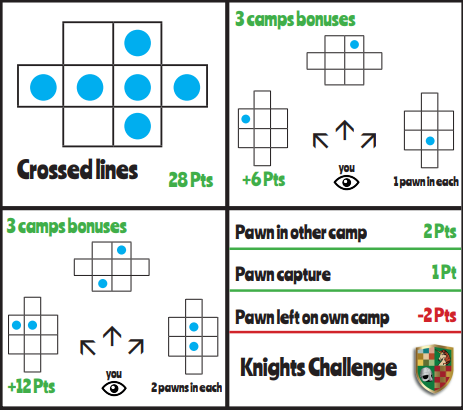|
Know the rules of Knights Challenge game
|
|
|
Around 1 HOUR to know the name of the master ! |
|
|
The boardA specially designed playing board with 4 separate camps in each corner matching the colour of their pieces (horses) 32 small horses (4 sets in different colours) representing the Knights Objective of the gameThe objective of the game is for each player to place their Knights in the opponents’ camps by moving across the board, whilst trying to score the maximum number of points before the end of the game. The game requires the combined skills of observation, anticipation and tactics. |

|
|
Playing the game
Players place their 8 Knights in the starting positions corresponding to their camp colour.
Moves by the Knights (as in Chess)To start, each player has to move a knight occupying a central square on his camp (the one on his left or the one on his right).
|
|
|
Capturing opponent’s piecesA Knight captures an opponent’s Knight when landing on a square occupied by an opponent’s Knight. Captured Knights are kept by the player and can no longer be played in the game. A captured Knight will count as 1 point for the player who captured it, at the final score. Captures are not allowed within the camps as well as on unicorn’s squares.
The End of the gameThe game ends when:- |
|
|
Safe squaresThese 8 safe squares on the playing board marked with a unicorn, symmetrically distributed around the playing board, allow players to shield some of their Knights from capture when they move forward. These Knights are in a strong position: they cannot be captured yet they can capture other Knights in their reach on their next move. StrategyThe game is won by the player who achieves the highest score (not necessarily the first to finish). Winning the gameThe game is won by the player with the highest score calculated as follows:- |
|
|
LINES OF KNIGHTS
Way to proceed with the count : It is preferable, for each player, to start counting the alignments first, then add the other knights. Oppponents’ Knights captured are worth 1 point. |
|
|
Camp bonusesBonus of 6 points - when a player has placed 1 Knight in each of the opponents’ camps, by the end of the game (in addition to the Knights’ value). Note: When a player’s two lines of Knights on same camp are crossed (i.e. one of 3 Knights and one of 4 Knights), the Knight placed at the crossing square is worth 8 points in the final count. Adding the score: count first the points of the lines of Knights and add points won by the other Knights, then add the bonuses and the points of captured Knights. |
Game for 2 or 3 players
For a game for 2 players choose 2 colours and 2 opposing camps.
In the simple version for 2 players the objective is to be the first to score 16 points, not including points gained by capturing opponent’s Knights, but including those from ‘lines of Knights’.
For a game with 3 players, dispense with pieces of the 4th colour and do not target the camp of the colour not being used. The tally-up of points is the same as in the game of 4 players, without counting the camp bonuses. The objective is to get 16 points, not including points gained by capturing opponents’ Knights, but including those from ‘lines of Knights’.
Variation for 2 players
Each of the 2 players make an alliance. The first between the red and yellow Knights, the second between the blue and green Knights.
Each player has 2 camps and 16 Knights. Play advances as with 4 players, alternating moves between colours (i.e. red, green, yellow, blue). The objective is to score the most points before one of the 2 alliances has succeeded in placing in the opposing alliance’s camps a minimum of 8 Knights, with at least 4 of each colour of own alliance.
At the end of the game only bonuses for ‘lines of Knights’ apply as per the game for individuals, albeit with a mixture of colours according to the alliance agreed by the 2 players at the beginning of the game.
Team game (Alliances : 4 players)
At the beginning the alliances are agreed between the players. The reds ally with the yellows and the greens with the blues. In the team game the allies play alternately in the usual order around the board.
The game is played in the same way as for four individual players, except that players within the alliance do not capture each other’s pieces.
The objective of the alliance of two players is to occupy only the squares of the opposite alliance’s camps.
The partners’ points are added together at the end of the game to determine the final team score. The scoring system is the same as for the 4 individual players except for a small variation in the camp bonus scoring.
To get a ‘line of Knights ‘ bonus (3 or 4 Knights), following agreement between the players at the beginning of the game, either the 2 colours of the alliance can be used to make a line or single colour lines only are accepted, as in the individual game.
Camp bonuses for Team game
In the Team game the rules concerning the camp bonuses are different to those for the individual game, as follows:
- 2 Knights of each colour of the alliance in each of the opposing alliance’s camps is worth 6 bonus points.
- 3 Knights of each colour of the alliance in each of the opposing alliance’s camps is worth 12 bonus points.
In a competition the alliance partners are not allowed to talk to each other nor make any kind of sign to each other.
How to mark points
Click here to download the new Score table for Knights Chalenge the Game.
COMMENTS - FEEDBACK ABOUT THE GAME
Open Google Form and give your feedback
You can see previous feedbacks int hat spreadsheet.

WHERE TO PLAY KNIGHTS-CHALLENGE IN EUROPE ?
In Belgium :
- Club In Ludo Veritas, à Namur
Rue de la Montagne 43a, Namur 5000
In England :
- Bad Moon Café, à Londres
159A Great Dover St. London, SE14GZ
- Chance & Counters Board Game Café
The Custard Factory, à Birmingham - West-Midlands
- Public Library,
High Street, à Stourbridge - West Midlands
In France :
- Association l’Ah-Toupie, à Chazelles - Charente (16)
- Bagdad Café, à Manot - Charente (16)
- Café des Artisans, rue de la gare, Roumazières (16)
- Centre social de Roumazières (CSCS) – Charente (16)
- EVS l’Oison, à Montmoreau - Charente (16)
- LCR des Plants orange, avenue de la Palette, Cergy (95)
- Médiathèque Visages du Monde, Cergy-le-Haut (95)
- Sortilèges, 1 rue des 3 croissants, Nantes (44)
- Parthenay (during the FLIP festival)
(More locations will gradually be added in 2024)

NEXT CHALLENGE
On Friday 29th March, you are welcome to join us at a Knights-Challenge
game session played at the Bagdad Café with Friends and adepts of the game
on a friendly evening (see poster ad).
This is a real opportunity to discover and train a bit ahead of the « Chevaliers
de Charente » Tournament on 6th April at Genouillac-Fontafie « salle des
fêtes ». We hope to see you there.


